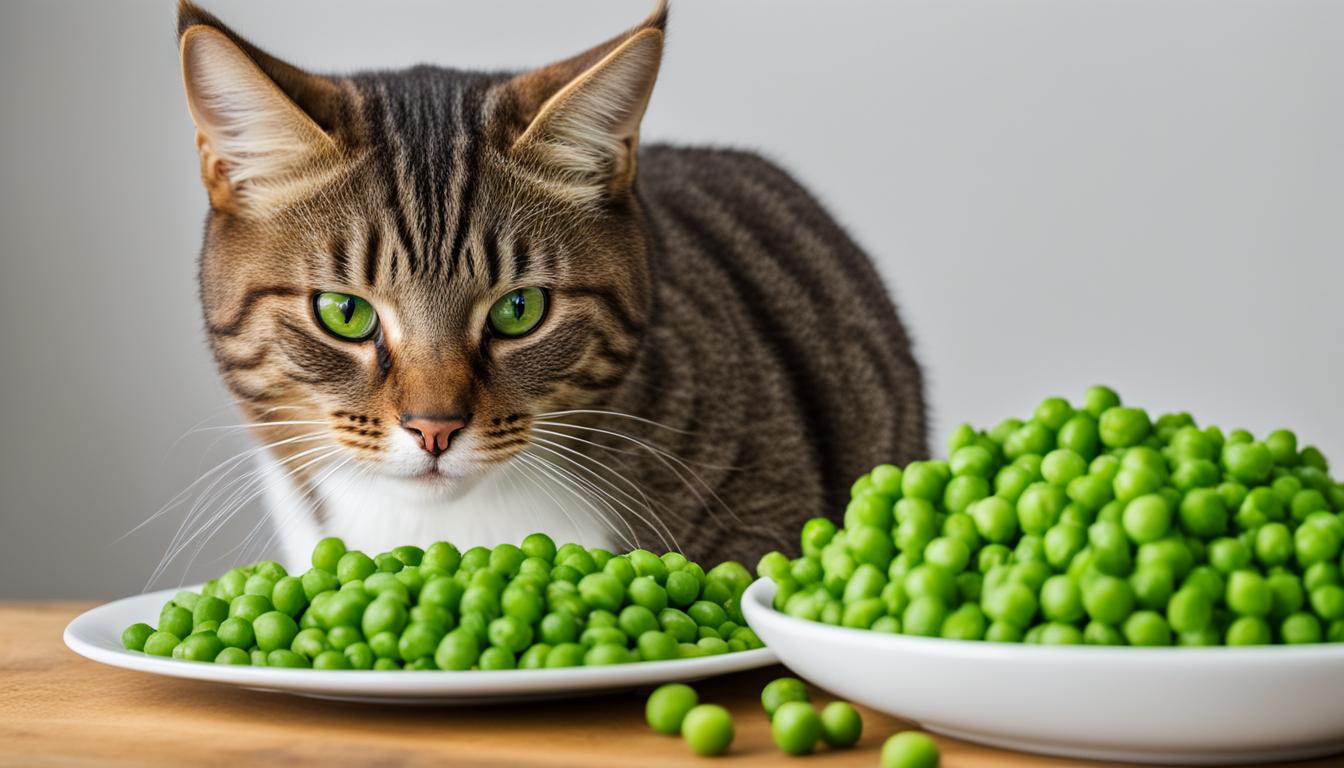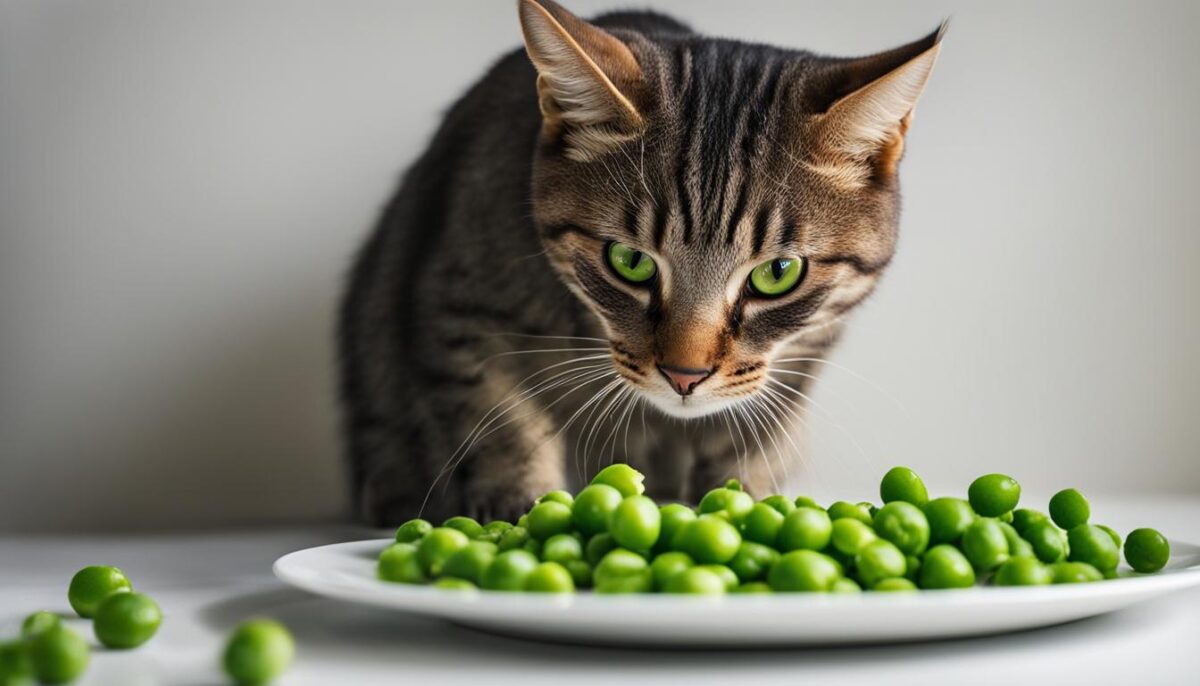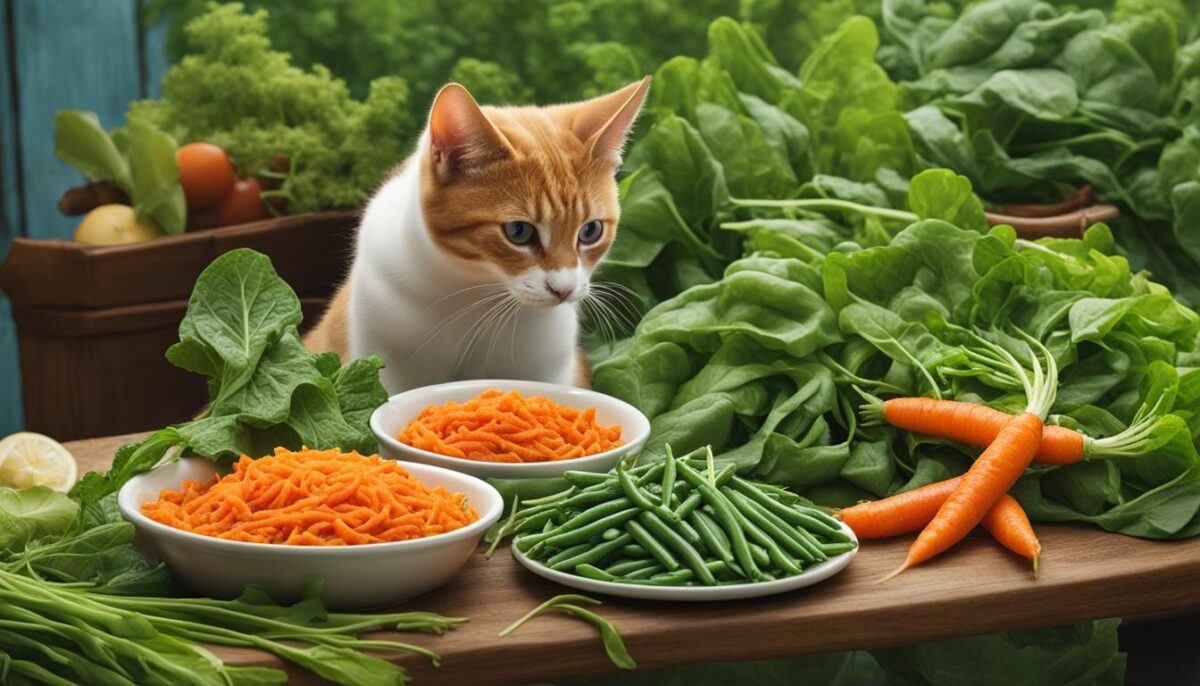Cats are primarily carnivores, but they can enjoy certain plant-based foods in moderation. Peas are a commonly asked about vegetable when it comes to cats. While cats do not have a biological need for vegetables in their diet, peas can be a safe and healthy addition to their meals.
Peas are rich in vitamins, minerals, and fiber, providing some nutritional benefits for cats. However, it is important to introduce peas gradually and in small quantities to prevent any digestive issues. As always, consulting with a veterinarian before introducing any new food to your cat’s diet is recommended.
Key Takeaways:
- Cats can eat peas in moderation as part of their diet.
- Peas are rich in vitamins, minerals, and fiber.
- Introduce peas gradually and consult with a veterinarian.
- Peas should not replace the majority of a cat’s diet.
- Other cat-friendly vegetables include carrots, green beans, and pumpkin.
The Benefits of Peas for Cats’ Diet
When it comes to cats’ diets, it’s important to provide them with a balanced and nutritious selection of foods. While cats are primarily carnivores, incorporating certain vegetables into their diet can offer some benefits. Peas, in particular, can be a valuable addition to a cat’s meals.
Peas are low in calories but rich in fiber, which can aid in weight management and digestion for cats. They also contain essential vitamins A, C, and K, which contribute to overall feline health. Additionally, peas are a source of plant-based protein, making them a valuable option for cats with specific dietary needs or restrictions. However, it’s crucial to remember that peas should never replace the majority of a cat’s diet, which should consist primarily of high-quality animal proteins.
The Nutritional Benefits of Peas for Cats
| Nutrient | Amount per 100g of Peas |
|---|---|
| Calories | 81 |
| Fiber | 5.1g |
| Vitamin A | 38µg |
| Vitamin C | 40mg |
| Vitamin K | 24.8µg |
| Protein | 4.4g |
Source: USDA National Nutrient Database
Introducing peas to your cat’s diet can be done gradually. Begin by offering a small amount of cooked peas as a treat or mixing them into their regular food. Monitor your cat for any signs of digestive upset or allergies. If they tolerate peas well, you can gradually increase the amount over time. Remember to consult with your veterinarian before making any significant changes to your cat’s diet.
While peas can provide some nutritional benefits for cats, there are other cat-friendly vegetables to consider as well. Cooked carrots, green beans, and pumpkin are among the vegetables that can be safe and healthy for cats. Always ensure that vegetables are well-cooked and mashed before feeding them to your cat, as raw vegetables can be difficult for them to digest.
Introducing Peas to Your Cat’s Diet
When it comes to introducing peas to your cat’s diet, it’s important to proceed with caution. While peas can be a healthy addition, not all cats may tolerate them well. To ensure a smooth transition, follow these steps:
- Start Slowly: Begin by offering a small amount of cooked peas as a treat or mix them in with your cat’s regular food. This allows your cat to get used to the taste and texture of peas.
- Observe for Reactions: Monitor your cat closely for any signs of digestive upset or allergies after introducing peas. Look out for symptoms such as vomiting, diarrhea, or excessive gas. If you notice any adverse reactions, stop feeding peas immediately and consult your veterinarian.
- Gradually Increase Quantity: If your cat tolerates peas well, you can gradually increase the amount over time. However, it’s important to remember that peas should still only make up a small portion of your cat’s overall diet.
Remember, every cat is unique, and what works for one may not work for another. If you have any concerns or questions about introducing peas or any other new food to your cat’s diet, it’s always best to consult with your veterinarian for personalized guidance.
The Pea Transition Plan
If you’re unsure how to go about introducing peas to your cat’s diet, here’s a simple transition plan you can follow:
| Days | Food |
|---|---|
| Days 1-3 | Regular cat food |
| Day 4 | Replace 10% of the regular food with cooked peas |
| Days 5-7 | Replace 20% of the regular food with cooked peas |
| Days 8-10 | Replace 30% of the regular food with cooked peas |
| Day 11 and beyond | Continue gradually increasing the amount of peas while monitoring your cat’s reaction |
“Introducing new foods to your cat’s diet requires patience and observation. Take it slow, and always prioritize your cat’s well-being. If peas don’t work out, there are other cat-friendly vegetables to explore.”
By following these guidelines and being attentive to your cat’s individual needs, you can safely incorporate peas into their diet and provide them with a varied and balanced meal plan.
Other Cat-Friendly Vegetables
While peas can be a safe vegetable for cats, there are other options to consider as well. Here are some cat-friendly vegetables that can be incorporated into your feline friend’s diet:
- Carrots: Cooked carrots are a nutritious option for cats. They are rich in beta-carotene, which is essential for maintaining good eye health.
- Green Beans: Green beans are another cat-friendly vegetable that can provide fiber and essential vitamins. They can be a healthy addition to your cat’s diet.
- Pumpkin: Pumpkin is known for its digestive benefits. It can help regulate your cat’s bowel movements and support a healthy digestive system.
When introducing these vegetables to your cat, it is important to cook and mash them to ensure easy digestion. Cats may have difficulty digesting raw vegetables, so it is best to serve them in a cooked and mashed form.
Remember, while vegetables can offer some nutritional benefits to cats, they should always be given in moderation and as a supplement to their regular diet. Cats primarily require high-quality animal-based proteins for optimal health, so vegetables should not replace the majority of their diet.
Table: Nutritional Comparison of Cat-Friendly Vegetables
| Vegetable | Nutritional Benefits |
|---|---|
| Carrots | Rich in beta-carotene for eye health |
| Green Beans | Provide fiber and essential vitamins |
| Pumpkin | Supports digestive health |
Foods to Avoid Feeding Cats
While it’s important to provide your cat with a balanced diet, there are certain foods that you should avoid feeding them. Some foods can be toxic and harmful to cats, causing a range of health issues. Here are some examples of foods that you should never feed your feline friend:
- Onions and Garlic: These vegetables contain compounds that can damage a cat’s red blood cells, leading to anemia.
- Grapes and Raisins: These fruits can cause kidney failure in cats.
- Chocolate and Caffeine: These contain substances called methylxanthines that are toxic to cats and can cause symptoms like vomiting, diarrhea, rapid breathing, and seizures.
- Alcohol: Even small amounts of alcohol can be poisonous to cats, leading to serious consequences.
- Artificial Sweeteners: Substances like xylitol, commonly found in sugar-free products, can cause a sudden drop in a cat’s blood sugar levels, leading to seizures and liver failure.
It’s important to be aware of these foods and make sure they are kept out of your cat’s reach. If you suspect that your cat has ingested any of these toxic foods, contact your veterinarian immediately for advice and guidance.
Table: Toxic Foods for Cats
| Foods to Avoid | Reasons |
|---|---|
| Onions and Garlic | Contain compounds that can damage a cat’s red blood cells, leading to anemia. |
| Grapes and Raisins | Can cause kidney failure in cats. |
| Chocolate and Caffeine | Contain substances that are toxic to cats and can cause vomiting, diarrhea, rapid breathing, and seizures. |
| Alcohol | Even small amounts can be poisonous to cats. |
| Artificial Sweeteners | Substances like xylitol can cause a sudden drop in blood sugar levels, leading to seizures and liver failure. |
Feline Nutrition and a Balanced Diet
When it comes to feline nutrition, it’s important to provide your cat with a balanced and healthy diet. Cats are obligate carnivores, which means their bodies are designed to thrive on animal proteins. While plant-based foods like peas can offer some nutritional benefits, they should only be given as an occasional supplement to their diet. The majority of a cat’s diet should consist of high-quality animal-based proteins.
Feeding your cat a well-balanced diet is essential for their overall health and well-being. It provides them with the necessary nutrients to support their immune system, maintain a healthy weight, and promote healthy digestion. A balanced diet should include a variety of proteins, such as lean meats, poultry, and fish, along with essential fats and carbohydrates.
The Role of Protein
Protein is a crucial component of a cat’s diet. It provides essential amino acids that cats cannot produce on their own. These amino acids are necessary for various bodily functions, including muscle growth and repair, enzyme production, and immune system support. It’s important to choose high-quality protein sources, such as animal meats, to ensure your cat receives all the necessary amino acids.
| Protein Sources | Benefits |
|---|---|
| Chicken | Lean source of protein |
| Turkey | Rich in essential amino acids |
| Fish | Source of omega-3 fatty acids |
In addition to protein, cats also require other essential nutrients such as fats, vitamins, and minerals. Fats provide energy and help with the absorption of fat-soluble vitamins. Vitamins and minerals play a vital role in maintaining overall health, including bone health, immune function, and organ function.
Providing your cat with a well-balanced diet that meets their nutritional needs is key to ensuring they live a long, healthy life. Consult with your veterinarian to determine the best diet plan for your cat, taking into consideration their age, weight, and any specific dietary requirements they may have.
Conclusion
While peas can be a safe and healthy addition to a cat’s diet, it is important to remember that they are not a necessary part of their nutrition. Cats require a diet that is primarily based on high-quality animal proteins. Peas and other vegetables should be introduced gradually and in moderation, and any dietary changes should be made in consultation with a veterinarian.
By providing a balanced and nutritious diet, along with regular veterinary care, you can help ensure the health and well-being of your feline friend. Remember, cats are primarily carnivorous animals, and their bodies are designed to thrive on animal proteins. While peas and other cat-friendly vegetables can offer some nutritional benefits, they should not replace the majority of a cat’s diet.
So, can cats eat peas? The answer is yes, but in moderation. Peas, along with other cat-friendly vegetables, can provide some vitamins, minerals, and fiber that can be beneficial for cats. However, it is always important to consult with your veterinarian before introducing any new food to your cat’s diet to ensure their safety and well-being. Your vet can provide guidance on how to meet your cat’s nutritional needs and help you create a balanced diet that supports their overall health.
FAQ
Can cats eat peas?
Yes, cats can eat peas in moderation. While cats are primarily carnivores, peas can be a safe and healthy addition to their meals.
What are the benefits of peas for cats’ diet?
Peas are low in calories, rich in fiber, and contain vitamins and minerals that are beneficial for a cat’s overall health. They can help with weight management and digestion.
How should I introduce peas to my cat’s diet?
Start by offering a small amount of cooked peas as a treat or mixing them with your cat’s regular food. Monitor your cat for any signs of digestive upset or allergies. If tolerated well, you can gradually increase the amount.
Are there other cat-friendly vegetables besides peas?
Yes, some other safe vegetables for cats include cooked carrots, green beans, and pumpkin. These vegetables provide additional nutritional benefits for cats.
What foods should I avoid feeding my cat?
Cats should not be fed toxic foods such as onions, garlic, grapes, raisins, chocolate, caffeine, alcohol, and foods containing artificial sweeteners.
What should a cat’s balanced diet consist of?
Cats require a diet that is rich in high-quality animal-based proteins. While vegetables can be given as occasional supplements, the majority of a cat’s diet should come from animal proteins.
Why is feline nutrition and a balanced diet important?
Feline nutrition and a balanced diet are crucial for a cat’s overall health and well-being. Consult with a veterinarian to ensure your cat is receiving a well-balanced diet.
Can peas replace the majority of a cat’s diet?
No, peas should not replace the majority of a cat’s diet. Cats require high-quality animal proteins as the main component of their diet.
Should I consult with a veterinarian before making any dietary changes for my cat?
Yes, it’s always recommended to consult with a veterinarian before introducing any new food or making significant changes to your cat’s diet.


